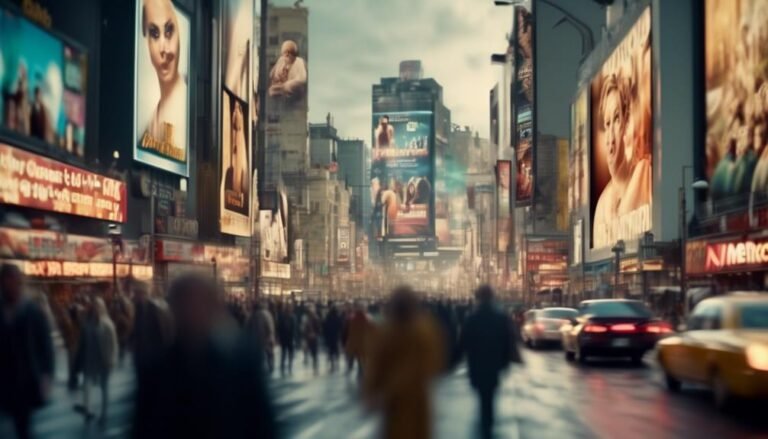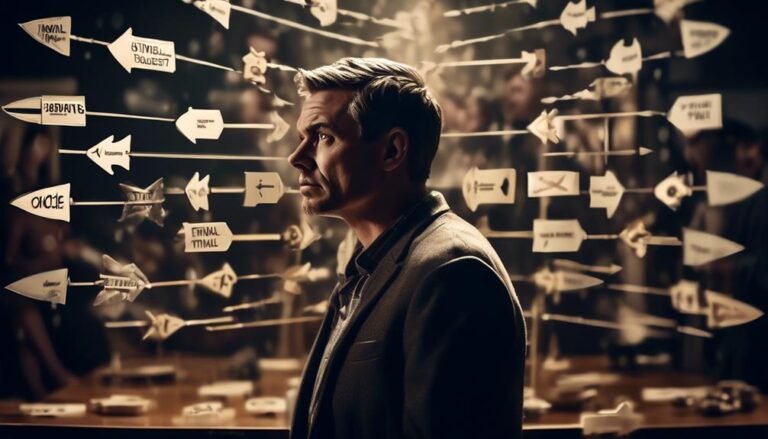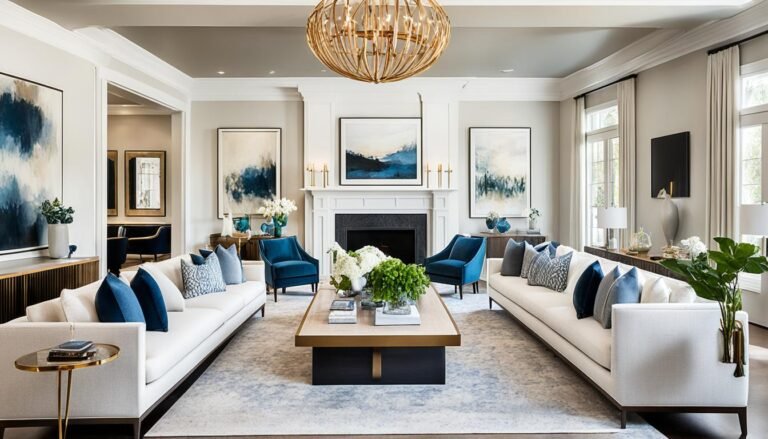Psychology of Retail Design
Did you know that the way a retail store is designed can have a profound impact on your shopping experience? From the colors on the walls to the layout of the aisles, every aspect of the store's design is carefully crafted to influence your behavior and ultimately, your purchasing decisions.
But have you ever stopped to think about why certain stores make you feel more inclined to spend money than others? In this discussion, we will explore the fascinating psychology behind retail design and uncover the secrets that make you want to stay longer, buy more, and keep coming back for more.
Get ready to discover the hidden tricks and techniques that retailers use to capture your attention and create a shopping experience like no other.
Key Takeaways
- Colors play a significant role in influencing consumer behavior, with warm colors creating excitement and cool colors creating a sense of calmness and trust.
- Creating a sense of urgency and scarcity through limited-time offers and exclusivity can motivate customers to make quick purchasing decisions.
- Store layout and design impact shopper behavior, with well-designed layouts guiding customers along a predetermined path and strategic product placement capturing attention and increasing the likelihood of a purchase.
- Sensory elements such as lighting, music, and scents work together to enhance the retail experience, engaging customers on an emotional level and increasing the likelihood of a purchase.
The Power of Color
The power of color in retail design is undeniable, as it has the ability to evoke emotions, influence purchasing decisions, and shape the overall shopping experience.
Colors have a profound impact on our subconscious associations and can create emotional connections with consumers. Understanding the psychology behind color can be a powerful tool for retailers to attract and engage customers.
Color plays a significant role in creating emotional connections with consumers. Warm colors like red and orange can evoke feelings of excitement and energy, making them ideal for attracting attention and encouraging impulse purchases. On the other hand, cool colors like blue and green are often associated with calmness and trust, making them suitable for creating a sense of relaxation and reliability.
In addition to creating emotional connections, colors also have subconscious associations that can influence purchasing decisions. For example, the color yellow is often associated with happiness and optimism, making it a popular choice for brands that want to convey a sense of positivity. Similarly, the color green is commonly associated with nature and health, making it a suitable choice for brands in the wellness industry.
Creating a Sense of Urgency
To successfully create a sense of urgency in retail design, you need to employ several effective techniques.
Time-limited offers, such as limited-time sales or flash deals, can create a sense of urgency by making customers feel they must act quickly to take advantage of a special opportunity.
Additionally, scarcity and exclusivity can drive urgency, as customers are motivated to purchase a product before it becomes unavailable or to gain access to exclusive items or experiences.
Time-Limited Offers
Creating a sense of urgency through time-limited offers is a powerful retail design psychology technique that compels customers to make quicker purchasing decisions. By using this strategy, retailers tap into emotional triggers that influence consumer behavior. Limited-time offers create a fear of missing out, triggering the instinct to act immediately. When faced with the possibility of losing out on a deal, customers are more likely to make impulsive buying choices.
Time-limited offers also increase the perceived value of a product or service. Customers perceive these offers as more exclusive and desirable, leading to a higher willingness to pay. Additionally, these offers create a sense of excitement and anticipation, driving customers to prioritize their purchase and act swiftly.
Incorporating time-limited offers into retail design is a powerful tool to motivate customers and boost sales.
Scarcity and Exclusivity
Does scarcity and exclusivity play a crucial role in creating a sense of urgency for customers in the retail industry? The answer is a resounding yes.
Scarcity marketing, a technique that creates a perception of limited availability, taps into our innate fear of missing out. When customers believe that a product or service is scarce, they're more likely to act quickly, out of fear that they may never have another opportunity to purchase it.
This sense of urgency can be further intensified by creating an aura of exclusivity around the product or brand. Luxury branding, for example, often utilizes scarcity and exclusivity to elevate their products to a level of desirability that transcends their functional value.
Limited Stock Availability
Limited stock availability is a powerful tool in the retail industry, compelling customers to take immediate action and secure their desired products. By creating a sense of scarcity, retailers tap into the psychological triggers that drive customer behavior.
When customers perceive that a product is in limited supply, they experience a heightened desire to possess it before it runs out. This sense of urgency can lead to impulsive buying decisions and increased sales for retailers.
Additionally, limited stock availability can create a fear of missing out (FOMO) among customers, further driving their purchasing behavior. By strategically managing stock levels and communicating limited availability to customers, retailers can effectively leverage this psychological tactic to stimulate demand and increase sales.
The Influence of Store Layout
The layout of a retail store has a profound impact on the behavior and decision-making of shoppers. Effective store layout can enhance the overall shopping experience, improve customer satisfaction, and ultimately increase sales. One key aspect of store layout is in-store navigation, which refers to the ease with which customers can move through the store and find the products they are looking for. A well-designed layout can guide customers along a predetermined path, strategically placing products and displays to capture their attention and influence their purchasing decisions.
To understand the influence of store layout, let's consider a simplified example of a grocery store layout in a 3-column and 5-row table:
| Column 1 | Column 2 | Column 3 |
|---|---|---|
| Entrance and displays | Fresh produce | Bakery and deli |
| Checkout area | Dairy products | Meat and seafood |
| Aisles | Frozen foods | Health and wellness |
| Promotional displays | Beverages | Household essentials |
| Exit | Snacks and sweets | Personal care |
Psychology of Product Placement
When it comes to the psychology of product placement, one key aspect to consider is the visual impact of placement. The way products are strategically positioned within a store can greatly influence how they're perceived by shoppers.
By placing certain items at eye level or in prominent display areas, retailers can capture the attention of customers and increase the likelihood of a purchase.
Understanding the influence of product placement on buying behavior is crucial for retailers looking to optimize their sales strategies.
Visual Impact of Placement
Product placement in retail design has a significant impact on the visual appeal and overall shopping experience.
The placement strategy and spatial arrangement of products play a crucial role in capturing the attention of shoppers and influencing their purchase decisions. When products are strategically placed in eye-catching locations, such as at the entrance or near high-traffic areas, they immediately draw the attention of customers, increasing the chances of them making a purchase.
Additionally, the spatial arrangement of products can create a sense of flow and ease of navigation within the store, enhancing the overall shopping experience. By organizing products in a logical and intuitive manner, retailers can guide customers through the store and help them discover new items.
The visual impact of proper product placement can't be underestimated as it directly affects customer engagement and ultimately drives sales.
Influence on Buying Behavior
Effective product placement in retail design has a profound impact on consumer purchasing behavior. The way products are strategically positioned in the store can greatly influence the decisions consumers make. Here are three ways in which product placement can evoke emotion and affect consumer decision making in the in-store atmosphere:
- Visibility: Placing products at eye level or in prime locations can grab the attention of shoppers, increasing the likelihood of them considering a purchase.
- Contextualization: By creating displays that showcase products in a specific setting or lifestyle, retailers can tap into consumers' aspirations and desires, making them more likely to buy.
- Cross-selling: Placing related products together, such as displaying matching accessories with clothing items, can tempt consumers to make additional purchases they may not have initially considered.
The Role of Lighting in Retail Design
Lighting plays a crucial role in shaping the overall atmosphere and customer experience within a retail space. The role of lighting extends beyond mere functionality; it has the power to evoke certain emotions and influence buying behavior. When used strategically, lighting can enhance the ambiance of a store and create an inviting and comfortable environment for customers.
One important aspect of lighting in retail design is its ability to complement the role of sound. Just like music, lighting can evoke specific emotions and set the mood within a store. Bright, well-lit areas can create a sense of energy and excitement, while softer, dimmed lighting can provide a more relaxed and intimate setting. By carefully considering the role of sound and lighting together, retailers can create a cohesive and immersive experience for their customers.
Moreover, the importance of ambiance can't be overstated. The right lighting can make a space feel warm, welcoming, and inviting, while the wrong lighting can make it feel cold and unappealing. Retailers must consider factors such as the color temperature, intensity, and direction of lighting to create the desired ambiance. Whether it's using spotlights to highlight certain products or creating a soft and diffused glow throughout the store, lighting can significantly impact how customers perceive and engage with a retail space.
Harnessing the Impact of Music
When it comes to retail design, music has a significant impact on the overall shopping experience. The emotional influence of music can create a connection with customers, evoking feelings of happiness, nostalgia, or excitement.
Music's Emotional Influence
Music's emotional influence on consumers is a powerful tool that retailers can harness to create a compelling and engaging shopping experience. By understanding the impact of music on our emotional response and subconscious influence, retailers can strategically use music to evoke specific emotions in their audience.
Here are three ways in which music can be utilized to create an emotional connection with consumers:
- Tempo and Rhythm: The tempo and rhythm of music can influence the pace at which consumers shop. Upbeat and fast-paced music can create a sense of excitement and urgency, encouraging customers to browse quickly and make impulsive purchases. On the other hand, slow and soothing music can create a relaxed and calming atmosphere, promoting a more leisurely shopping experience.
- Genre and Style: Different genres and styles of music evoke different emotions. For example, classical music can create a sense of sophistication and elegance, while pop music can evoke feelings of energy and familiarity. Retailers can choose music that aligns with their brand image and target audience to create a desired emotional response.
- Volume and Sound Level: The volume and sound level of music can have a significant impact on the emotional experience of consumers. Loud and energetic music can create a lively and dynamic atmosphere, while soft and gentle music can foster a sense of intimacy and tranquility. Retailers can adjust the volume and sound level of music to complement the desired shopping environment and evoke specific emotions in their customers.
Creating a Sensory Experience
To create a truly immersive shopping experience, retailers must harness the impact of music and utilize it as a powerful tool for engaging and captivating customers. Music has the ability to influence our emotions, memories, and behaviors, making it an essential component of multi-sensory branding in retail spaces. By strategically selecting and playing music that aligns with the brand identity and target audience, retailers can create a unique atmosphere that enhances the overall shopping experience. The right music can evoke certain emotions, create a sense of excitement or relaxation, and even influence purchasing decisions. It can also serve as a powerful memory trigger, connecting customers with positive experiences and reinforcing brand loyalty. Incorporating music into retail design allows for the creation of immersive environments that appeal to all the senses, resulting in memorable and impactful retail experiences.
| Benefits of Harnessing Music in Retail Design | Examples |
|---|---|
| Enhances brand identity | – Playing upbeat and energetic music in a sports apparel store |
| Influences customer emotions | – Relaxing instrumental music in a spa or wellness store |
| Creates a memorable shopping experience | – Playing nostalgic songs in a vintage clothing boutique |
| Increases customer engagement | – Interactive displays that allow customers to create their own soundtracks |
| Reinforces brand loyalty | – Using a signature jingle or theme song in advertisements and store ambiance |
Using Scents to Enhance the Shopping Experience
Using carefully selected scents in retail environments has been proven to significantly enhance the overall shopping experience for customers. This practice, known as scent marketing, taps into the power of fragrance influence to evoke emotions and create a memorable atmosphere.
Here are three ways in which scents can enhance the shopping experience:
- Creating a welcoming ambiance: When customers are greeted by pleasant scents upon entering a store, it immediately sets a positive tone for their shopping experience. Fragrances like citrus or vanilla can create a warm and inviting atmosphere, making customers feel comfortable and more inclined to explore the store.
- Triggering positive associations: Scents have the ability to evoke memories and emotions. By using scents that are associated with positive experiences, retailers can tap into customers' nostalgia and create a sense of familiarity. For example, the smell of freshly baked bread in a grocery store can remind customers of home and create a comforting and enjoyable shopping experience.
- Enhancing product perception: Certain scents can influence customers' perception of products. For instance, using a floral scent in a clothing store can make customers associate the clothes with freshness and elegance. This can result in increased customer satisfaction and a higher likelihood of making a purchase.
Incorporating carefully chosen scents into the retail environment can have a profound impact on the overall shopping experience. By creating a welcoming ambiance, triggering positive associations, and enhancing product perception, retailers can effectively engage customers on an emotional level and increase their likelihood of making a purchase.
The Psychology of Pricing
The pricing of products and services in retail environments isn't simply a matter of setting a number, but rather a strategic and psychological endeavor aimed at influencing consumer behavior and maximizing sales. Understanding the psychology of pricing is crucial for retailers to effectively attract and persuade customers.
Consumer decision making is heavily influenced by the way prices are presented. One key aspect of pricing psychology is the concept of price perception. Consumers often rely on reference prices, such as comparing the current price to a previous price, to evaluate the value of a product. By emphasizing discounts or limited-time offers, retailers can create a sense of urgency and encourage immediate purchases.
Another important factor in pricing psychology is the use of price anchors. By placing a higher-priced item next to a lower-priced item, retailers can make the lower-priced item seem like a better deal, leading to increased sales. Additionally, using odd or unconventional prices, such as $9.99 instead of $10, can create the perception of a bargain and attract price-sensitive consumers.
Furthermore, retailers can employ the strategy of price bundling to increase sales. By offering a package deal or combining products or services together at a discounted price, consumers perceive greater value and are more likely to make a purchase.
Designing for the Senses
Designing for the senses involves creating retail environments that stimulate and engage customers through their sensory experiences. By carefully considering the impact of touch and sound, retailers can create immersive and memorable experiences that evoke strong emotions in their audience.
To evoke emotion in customers, designing for touch can play a crucial role. Incorporating tactile elements such as soft fabrics, textured surfaces, or interactive displays can create a sense of comfort, pleasure, or curiosity. When customers can physically connect with the products, it enhances their overall shopping experience and fosters a deeper emotional connection.
In addition to touch, incorporating sound into retail design can also evoke powerful emotions. Background music can create a specific atmosphere, whether it's calming, energetic, or nostalgic, influencing the mood and behavior of customers. Sound effects, such as the subtle sound of a waterfall in a spa or the sizzling sound of food being cooked in a restaurant, can further enhance the sensory experience, evoking emotions related to relaxation, hunger, or excitement.
The Importance of Visual Merchandising
Visual merchandising plays a pivotal role in capturing and maintaining the attention of customers, influencing their purchasing decisions, and shaping their overall perception of a retail space. It goes beyond arranging products on shelves; it's about creating emotional connections and storytelling through visual displays.
When customers walk into a store, the first thing they notice is the visual presentation. The way products are displayed, the use of colors, lighting, and props all work together to create an atmosphere that communicates the brand's identity and values. By strategically arranging merchandise and creating visually appealing displays, retailers can evoke certain emotions in customers, such as excitement, comfort, or nostalgia.
Visual merchandising also serves as a powerful tool for storytelling. Through carefully curated displays, retailers can convey a narrative that resonates with customers and enhances their shopping experience. Whether it's a display showcasing the latest fashion trends or a window display with a captivating story, visual merchandising enables retailers to engage customers on a deeper level and establish a connection that goes beyond the transactional.
Moreover, visual merchandising has a direct impact on purchasing decisions. Well-executed displays can influence customers' perception of product quality, inspire impulse purchases, and encourage them to spend more time exploring the store. By strategically placing complementary products together or highlighting special promotions, retailers can guide customers through the buying journey and increase the likelihood of conversion.
Conclusion
In conclusion, the psychology of retail design holds immense power in influencing consumer behavior. By strategically using color, creating a sense of urgency, and carefully designing store layouts, retailers can manipulate shoppers' perceptions and drive sales.
The placement of products, the role of lighting, and even the use of scents all play a crucial role in enhancing the shopping experience. Moreover, pricing strategies and visual merchandising techniques can further entice customers.
Remember, in the world of retail, perception is everything, and a well-designed store is worth its weight in gold.







